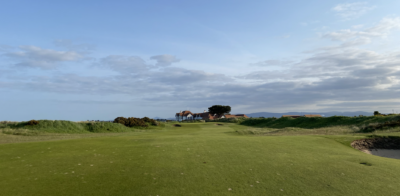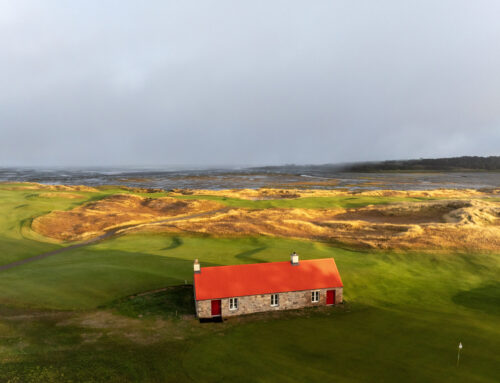Today, the news was officially announced that Portmarnock Golf Club, the historic Dublin links, is seeking government support to host the AIG Women’s Open and The Open in the coming years. It would be the first time the trophies are taken outside of the United Kingdom and to the Emerald Isle. Yet, golfing purists would not be surprised by the decision to go to Portmarnock. It is an elite championship links with a rich history and is already due to host the Women’s Amateur Championship next year.

(Image Credit: Portmarnock Golf Club)
In light of the news, I took some time to learn a little more about Portmarnock, a course which I played for the first time this year and am itching to go back to. Here are 5 things you must know:
- The original course design was overseen by Mungo Park in 1893/4
Brother to Willie, the first ever winner of an Open Championship in 1860, Mungo was a renowned golfer in his own right. Born into a family of farm labourers in Musselburgh in 1836, Mungo went on to win the 1874 Open at his home links. He originally worked as a seaman, but returned to the game of golf in his 30’s.
Making a name for himself as a skilled clubmaker and teacher of the game, founders of Portmarnock, William Chalmers Pickeman and George Ross sought his services to supervise the course’s development in the early 1890’s. They had originally spotted the peninsula, which was on the land of notable distiller John Jameson, as suitable ground for golf. The same land had been used prior by Jameson as a private plot for golf. Mungo stayed on for a year to serve as the Club’s first professional, too.
The original layout was built on the 500-acre Portmarnock peninsula as a 9 hole course, although this was shortly lengthened to a full 18 in 1896 by George Coburn. Just three years later, in 1899, the Irish Open Amateur Championship was held on the nascent links and won by none other than the great John Ball. He won the final 13&11 (played over 36 holes)
- Host to Ireland’s first Professional Open
1927 would prove to be a landmark year in the progression of professional golf upon the island of Ireland. An initial prize fund of £1,000 attracted many of the game’s contemporary great players, including Henry Cotton and JH Taylor. George Duncan of Scotland took home the first place prize of £150 that year in an event that cemented Portmarnock as one of Ireland’s most prestigious links.
The tournament would alternate between venues north and south of the border every year.
Portmarnock has gone on since to host the greatest number of Irish Opens (19). In distant second lies Royal Dublin with 6. Portmarnock has crowned an illustrious list of Irish Open winners over the years: Fred Daly, Seve Ballesteros, Bernhard Langer and Michael Campbell to name but a few.
Taking the Irish Open in isolation, Portmarnock has always been a provider of great champions.
- The 1991 Walker Cup
Phil Mickelson showed a glimpse of what was to come during his performance at the 1991 Walker Cup at Portmarnock. On the final afternoon, he is said to have wowed all of the onlookers with a sensational flop shot from a typically tight links lie from behind the 18th green. Nestling up to a couple of feet, it helped him defeat Jim Milligan and the US side comfortably defeat GB&1 by 14 points to 10. Playing at Portmarnock this year, I was also informed by a member that he hit the formidable par 3, 15th green playing both left and right handed.
Some elite names were in participation that week: Padraig Harrington, Garth McGimpsey, Paul McGinley, David Duval and Bob May.
Portmarnock has always been a strong supporter of Amateur Golf. It has hosted the Amateur Championship on two occasions, the St Andrews & Jacques Léglise Trophy in 2012 and the European Men’s Amateur Team Championship in 1997. That year saw such names as Justin Rose, Sergio Garcia and Henrik Stenson take on the links.
Portmarnock also warmly welcome the golf teams from both University College Dublin and Trinity College Dublin to play their competitive fixtures.
- A Natural and Beautiful Links
Due to its situation on a peninsula, the course is surrounded on three sides by the sea; meaning the wind is always a huge factor. Whilst lacking the crashing dunes of Royal Portrush, Royal County Down or many of the West Coast links, Portmarnock is not short in natural undulations and run offs eager to capture your ball.
Whilst at 7,500 yards from the championship tees, Portmarnock has ample length to test the longest hitters in the game, perhaps the course’s biggest defence are the greens. Subtly undulating but always lightning quick and true, you rarely have a straightforward putt. Miss the surfaces at your peril, too. Runoffs and pot bunkers a plenty will frequently leave you treacherous pitch and chip shots.
The 15th is perhaps the signature hole – a stern par 3 that often plays into the wind has runoffs either side that will collect anything but a beautifully struck iron shot. The 15th is followed by one of the toughest finishing stretches in links golf. At the end of it, though, Portmarnock’s clubhouse is one of the best places to enjoy a post-round debrief

- A Bright Future
The announcement reflects the widely perceived view that Portmarnock is a venue worthy and deserving of hosting our game’s most prestigious tournaments. With the Women’s Amateur next year, it will be interesting to see how the course is set up and how the competitors fare around what can be a brutally tough test of golf.
There are many, no doubt, who believe Portmarnock should be a top contender to host an Open Championship. There have been rumours about this for some time and it would make sense. Only 10 miles from Dublin Airport, it is well connected and easily accessible. The course has enough length and space for the huge crowds The Open now draws.
Rory McIlroy, speaking this year confirmed:
“I think there’s every chance that they’re seriously looking at it… There has to be a lot of stuff that that makes sense. But, you know, having a course that’s so close to a major city, so close to a major airport, having a great golf course, I think it would be amazing.”
An Open in Ireland would be tremendously well supported, and the Club has all the pedigree, class and test to stand up to the task.






